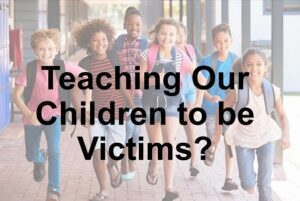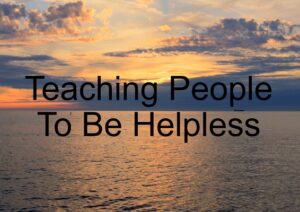A while ago I wrote an article that brought great response about how some training circumstances and tools used by our military services today may actually be teaching our soldiers to die. What I mean to say is that the training may be conditioning them to expect their own death. In recent months I’ve been studying instances of violence where American citizens didn’t fight back; didn’t defend themselves; essentially were willing victims. As I’ve examined these instances I noticed somewhat of an age cap on the “willing victims” and I saw a link to our public school system and some policies that were developed in the late ’70s and early ’80s. This is a topic I’ve written about before, but I felt I needed to do some further study, and in this article I’m going to share some of that newly gleaned information with you. Additionally, I’m going to share a story about a thirteen year old 8th grader who, just in this past week, observed a set of circumstances in her school that led her to believe something might not be right. She shared her story with her father and he became VERY alarmed. We’ll discuss why.
Let me open with the first online search I did with regard to the topic of students, school violence and the zero tolerance policy. I Googled “zero tolerance violence schools” and received about 158,000 hits. Almost the entire first page of responses is full of links to articles espousing what a great idea zero tolerance is. The other side of that is that most of them are from schools or school systems.
In an online research paper from the Virginia Youth Violence Project (http://youthviolence.edschool.virginia.edu/violence-in-schools/zero-tolerance.html), the following definition of a zero tolerance policy – as it applies to school violence – can be found:
“Zero tolerance” refers to the practice of automatic expulsion of students for violations of school safety rules.
In the first paragraph of the same paper the following statement is made:
In recent years, anxious educators have relied increasingly on zero tolerance policies as a simple, albeit draconian, response to student threats of violence that relieved them of the need to exercise judgment and make reasoned decisions in response to student infractions.
I have previously commented on how “zero tolerance” relieves the teachers of any need to exercise judgment. No longer would they have to try to figure out who hit who first; no longer would they have to try to figure out if an act of self-defense was REALLY an act of self-defense or if that was an excuse being used to justify hitting someone. With the simple enactment of “zero tolerance” the teachers’ lives would become easier.
While the pros and cons of zero tolerance can be debated intelligently, the abuse of zero tolerance policies is easy to find. Such abuse goes beyond all reasonable limits of common sense and include:
- A five-year-old in California was expelled after he found a razor blade at his bus stop and carried it to school and gave it to his teacher.
- A nine-year-old in Ohio was suspended for having a 1” knife in a manicure kit.
- A seventeen-year-old in Chicago was arrested and subsequently expelled for shooting a paper clip with a rubber band.
- A ten-year-old boy was expelled from elementary school because he brought a 1″ plastic toy pistol for his G.I.Joe action figure to school.
I never thought I’d quote anything from Harvard University, but in the 2000 report titled “Opportunities suspended: Devastating consequences of zero tolerance and school discipline“, there is the following statement:
“Zero Tolerance has become a philosophy that has permeated our schools; it employs a brutally strict disciplinary model that embraces harsh punishment over education.”
Certainly it makes sense to have a zero tolerance policy against weapons in our schools possessed by the students. By the same token, punishment for violation of such policy shouldn’t be absolute across the board. It should be determined on a case by case basis. Further, a zero tolerance policy against weapons shouldn’t be blindly expanded to include any and all forms of misbehavior that may (or may not) result in injury to any student. Just because weapons can be used to commit acts of violence doesn’t mean that all acts of violence (or minor physical aggression) should be treated as weapons violations.
Expressing a different point of view, the website for National School Safety and Security Services (NS4) has a page devoted to zero tolerance. The page consists of twelve paragraphs and of the twelve, six mention discipline; four mention fair and impartial administrators; and almost all of them talk about prevention. If you read the page you find that the NS4 proclaims “zero tolerance” as the savior of all our children! (okay; so I am exaggerating a bit, but not much).
From the Indiana State Education website we get [perhaps] a better glimpse into how academia perceives “zero tolerance”:
Zero tolerance school discipline has been intended primarily as a method of sending a message that certain behaviors will not be tolerated, by punishing both major and minor offenses severely. The term caught on among educators concerned about a near-epidemic of youth violence, and school boards across the country adopted zero tolerance policies for a range of disruptive behaviors.
The things that catch my eye there are the “punishing both major and minor offenses severely” and “for a range of disruptive behaviors”. I have a problem with giving the same punishment for major and minor offenses. As a cop I always think in those terms and I just can’t see punishing the speeding driver the same way as the serial rapist even though they’ve both committed offenses. Further, “disruptive behavior” is a pretty subjective term. What I find disruptive the next teacher may not – or another teacher may find to be WAY over the boundaries of acceptable behavior.
Even just by looking at these few online resources we can see – within academia itself – how different the opinions can be about zero tolerance policies and whether they are beneficial or – at best – a mixed blessing. But I feel it’s important to look at how such policies can affect our children as they grow. For those of you who have read my writing about this topic before, feel free to skip the next paragraph.
When Little Johnny five-year-old goes to Kindergarten for the first time and he ends up in a disagreement with Little Bobby five-year-old about who was playing with what toy first, it is not a matter for the zero tolerance policy to determine. Unless Little Johnny or Little Bobby pull out a weapon and commence to attack, the worst that’s going to happen is that one little boy is going to hit another little boy. One little boy will cry. If the return punch is thrown then both little boys might cry. This isn’t a call for disciplinary action. It’s a call for the teacher to step in, instruct the boys that fighting is unacceptable to solve such disputes, encourage them to shake hands and continue on playing in the same sand box. But if Little Johnny five-year-old gets punished with a day of in-school supsension for defending himself when Little Bobby throws a punch, then you can bet Little Johnny will remember it. Then, when Little Johnny is nine and someone hits him for something, he’s going to think twice about hitting back. If he does and gets punished then that’s twice the school has taught him that he’s wrong for defending himself. There is no excuse for violent behavior. Then when Little Johnny isn’t so little anymore because he’s thirteen or fifteen and someone attacks him in the school restroom because they want his coat or he walked in on a drug deal and they don’t want witnesses, Johnny has certainly learned that fighting back is unacceptable and he’s better off just taking the ass-whipping. If none of you are feeling too bad about Little Johnny make that same story about Little Suzie and decide whether or not she’ll fight back when someone attempts to rape her in college. What do you think?
Now, for all of you who think that there really isn’t much violence in our schools and I’m just a paranoid parent teaching my kids to be ready to rage against the wind, let me remind you of a few things that have happened in the past couple decades:
- Columbine ’99
- Santana High School ’01
- Appalachian School of Law ’02
- John McDonogh High School ’03
- Red Lake High School ’05
- Platte Canyon High School ’06
- Virginia Teach ’07
- Springwater Trail High School ’07
- Success Tech Academy ’07
- Northern Illinois University ’08
Note that I intentionally left out the attack at Beslan Middle School #1 in Beslan, Russia in 2004. While I do firmly believe that training our children to not fight back is a horrendous crime committed on the part of our academic systems, I don’t know that – in the long run – it will teach them to resist attackers such as the fanatical Muslim Chechens that attacked at Beslan. However, the general mindset is definitely affected. If you teach children to be sheep then they’ll be sheep. If you teach children to stay alert and be ready to defend themselves then that is the attitude they take forward. Let me give you an example and we’ll talk about that 13-year-old girl I mentioned at the beginning.
In the northeastern part of our beautiful country, just in this past week, a girl went to school on Tuesday and in one of her classes she had a substitute teacher. It was a substitute she had never seen before. He appeared caucasian, below middle-age, with a Baltic accent (she compared it to Polish or Russian but didn’t recognize it as either one). What got her attention was that the substitute told the class he was giving them no work, that they should turn in their completed “take home” tests and then sit quietly for the remainder of class. Most 13-year-olds don’t complain about such easy classes, especially near the end of the school year, but the young lady noticed that this substitute wasn’t wearing the usual identification tag/badge worn by substitutes in that school.
On that same Thursday the substitute was back and the girl had to ask some questions. She was smart enough not to ask the substitute why he was again in class without the proper identification but when she asked in the main office she was told that substitute teacher had called in sick and wasn’t even in the school. When the girl insisted that she’d just had that substitute for class the office staff questioned her credibility and went so far as to call the substitute at home – where they reached him by phone. The substitute in question – or at least the name given – was an elderly man who hadn’t been to school at all that week. A check of the logs showed that the substitute had signed in using that name but had not signed out on either day; a condition which meant that he wouldn’t get paid. The school’s response to this? The elderly substitute must be suffering from Alzheimer’s disease and just didn’t remember having been there.
The girl wasn’t quite that stupid. She went home and shared the information with her father – a disabled military veteran – and he took up the issue with the school and the school board. Although they still haven’t actually admitted that anything untoward might have happened (like a complete stranger with no business in the school signing in, walking the halls with no badge, teaching a class, gathering papers with names and then leaving without signing out on not just one but TWO days in the same week) they did finally admit that their might be an issue that they’d have to investigate. Last I heard that young lady – the 13-year-old – was enjoying a summer vacation that started early because her father wasn’t going to send her back to that school and she only had three days left anyway.
What concerns me most about that story – and every word of it is true – is that the school didn’t seem at all worried about its own safety issues. The school staff seemed oblivious to the responsibility it holds in providing a safe and secure learning environment. Oh, wait… I forgot. They provide such an environment by suspending and expelling students who draw a picture of a futuristic laser gun in art class because they have a zero tolerance policy against weapons.
Listen up America: WE CANNOT AFFORD THIS ATTITUDE.
Our children are our most precious asset. If we can’t protect and train them properly then those tasked with the job of doing both should be replaced as fast as we can. If those tasked to do the job don’t think they can, or don’t like how they might have to, or find the work too stressful, then they should look for other employment. Teaching is not for the lazy. Teaching is not for the lethargic or slow-minded. Teaching is not for those who believe that every problem in the world can be solved with another policy.
Have you looked at your children’s schools and the local school board lately?
What do you think?
BE SAFE!
– – – – –
If you enjoyed this parenting article, please check out my book, “Father to Son” available for your kindle or in paperback. Only on Amazon: http://amzn.to/2ktfYDX



